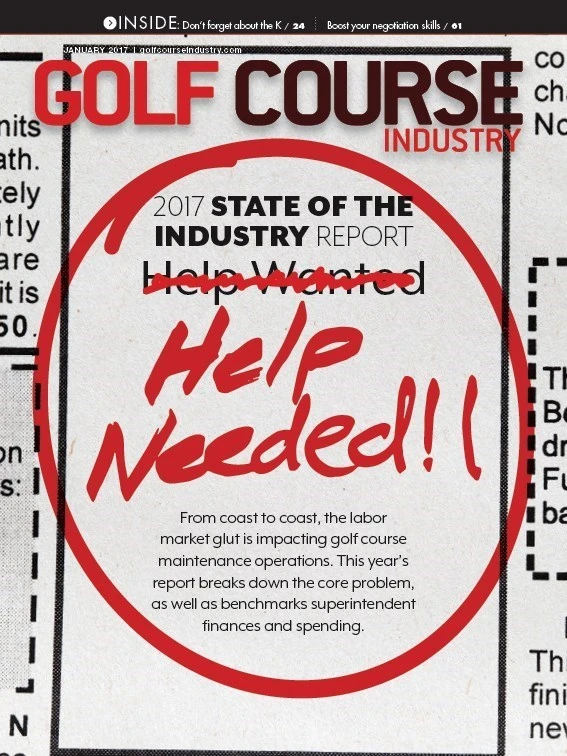_fmt.png)
Every superintendent is familiar with the reminder that begins “An ounce of prevention ...” That’s certainly true when the subject is irrigation pumps. Properly maintained, a pump can provide a quarter-century of service.
But some in the industry are lax when it comes to pump maintenance issues, says Brian Vinchesi, a design engineer for Irrigation Consulting Inc. “A lot of guys, if (the irrigation pumps) are working correctly, and they aren’t having trouble, they don’t go down and look at them very often,” he says.
Technology is at the heart of the matter. Today’s computer-driven systems can be monitored remotely via tablet or smartphone. But Vinchesi maintains that monitoring a pumping station from the comfort of home, or perhaps from a vehicle on the 14th fairway, is not a substitute for an in-person inspection. “You should be checking on it, at least on a weekly basis, if not a daily basis,” he says. “But the way they run now, they’re so bulletproof that a lot of guys just get real complacent and don’t (inspect them) until something is going wrong. I’m a big fan of checking on them once a week.”
Superintendents avoiding the pump house may not learn of a potential problem until it becomes a major headache. “They don’t go to (the pump house) unless something goes wrong,” Vinchesi says. “They’re all monitored remotely so what happens is, they’ll find out if something goes wrong because the irrigation won’t work, but they don’t go to the pump house or the pump station unless they have to. That’s a really common mistake.”
Putting off preventative pump maintenance is another common problem. In fairness, budgetary issues sometimes prohibit these measures. But by putting off routine maintenance superintendents open the door to potential – and often costly – problems.
“They don’t do preventative maintenance,” Vinchesi says, “they do reactive maintenance. What they do is they wait for something to break before they fix it. There are certain things you should do on a regular basis.”
Doing routine maintenance on a pump is not unlike performing the same task on a car or a truck and it offers the same rewards. Handling routine maintenance chores promptly requires some time and expense. But doing so is a big step toward preventing relatively minor issues from escalating into major problems and expenditures. Here are a few suggestions.

Don’t forget about the PUMP filter
Manually clean filters on a regular basis as opposed to backwashing them. Bryan Weemes, who services pumps for Rain Bird, says this is particularly important with the Y-screen filter that is prevalent in the industry. “When a Y-screen filter is being used, there is only so much of that this is going to be cleaned, not the whole screen,” he says. “I would say less than 50 percent. That may be adequate with some systems, but the other parts of the screen tend to get a buildup on them. They need to be pulled down and cleaned with a high-pressure washer or whatever at least once or twice a year.”
The proper interval between cleanings varies by individual circumstances.
“Is it necessary to do it every three months or was it not?” Weemes says. “Maybe six months is too long. You have to determine that frequency by doing it. But it is highly recommended that is done. Sometimes fish bones, shale or other organic materials get in the screen. The washer just can’t clear it. The stuff just won’t come out. It needs to be manually cleaned.”
Disassembling the filter for cleaning also provides an opportunity to examine parts to see if they are wearing out or need to be replaced. “Check for unexpected wear,” Vinchesi says. “Look at the part, to see if it’s wearing or thinning out because a lot of those parts are plastic. So you want to look at that.”
Lubricate
Lubricate all electric motors properly, preferably using a grease meter as opposed to simply a certain number of applications. The amount of lubricant should be monitored carefully, Weemes says.
“A lot of service professionals say, ‘I use two to five shots (of lubricant per year),’” he says. “There are vents on the same motors most of the time. If you put too much grease in there, it will go through the vents. But often those vents are clogged and the grease collects dust, there is moisture in the air, whatever, and you burn out the motor due to not properly greasing it, adding too much grease or not doing it based on time and the motor manufacturer’s recommendations.”
Listen carefully
Spend time in the pump house listening to the machinery in operation. “Go down maybe once a quarter or twice a year and spend some time there and listen to it,” Vinchesi says. “Just go in there and listen to how it’s running. And that will tell you a lot. Nobody’s looking to spend much time in the pump house, but you should listen to how the pumps are turning on and off and how the pumps are switching. You’ll figure out very quickly if it’s (working properly).”
Check connections
Periodically check to be sure pump gauges are working properly, wires are properly connected, connections are tight and surge arresters are grounded properly.
“Surge arresters are merely expensive paperweights if they are not coupled to an adequate grounding grid,” Weemes says. “Lower is better. Check ground resistance often.”

Bring in a pro
Once every 10 years, motors and pumps should undergo a thorough checkup from a qualified service professional. This is not inexpensive, but Vinchesi says it’s a necessary step.
“Every 10 years you need to have your motors and your pumps checked,” he says. “You don’t want to wait for them to get to Year 13, 14 or 15 when they just break.”
Every 10 years you need to have your motors and your pumps checked.” — Brian Vinchesi
Budget properly
Give the pump and the pumping station an annual cleaning. “It’s amazing how much longer it lasts if you do that,” Vinchesi says. “It doesn’t need a lot of maintenance, but if you don’t do the maintenance, when it breaks it’s very expensive.”
Vinchesi estimates an irrigation pump could last 25 years if it’s maintained properly, but perhaps only 15, or even less, if it is not. He strongly suggests superintendents set aside funds for maintenance in their annual budgets, particularly for a once-a-decade checkup. “That’s not going to be cheap,” he says.
There are service contractors that provide pump maintenance services but those services are not inexpensive and Vinchesi advocates a hands-on approach. “If you go down and look at it yourself,” he says, “you’ll know when something’s not working.”

Explore the January 2017 Issue
Check out more from this issue and find your next story to read.
Latest from Golf Course Industry
- SePRO to host webinar on plant growth regulators
- Turfco introduces riding applicator
- From the publisher’s pen: The golf guilt trip
- Bob Farren lands Carolinas GCSA highest honor
- Architect Brian Curley breaks ground on new First Tee venue
- Turfco unveils new fairway topdresser and material handler
- Ignite Attachments adds new box plane and grapple
- Mackenzie & Ebert working on new Caribbean course





